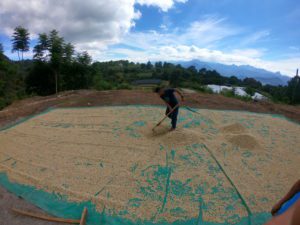Top 10 Interesting Facts About Coffee
As coffee growers in Honduras (Copán) coffee knowledge and facts are prized possessions we collect. The most fun coffee facts are on display today. We don’t just grow and export high-altitude coffee. We spread coffee love and good cheer. Celebrating coffee, and celebrating with coffee never gets old. With an increasing number of coffee brands and tasting opportunities (especially single-origin coffees), it’s fun to delve into the variety. Now for the fun facts about the world’s number two beverage following water.

-
Coffee was originally chewed. This munching took place long ago in Africa.
Chewing coffee sounds too intense nowadays; it seems like a dare. However, this was indeed the practice. Coffee was mixed with ghee (straight butterfat) and eaten for energy. Combining it with animal fat was another option. Think about life in simpler times, when dense energy sources and carrying power were scarce. What better simple combination to provide long-term and short-term energy than a lump of coffee and animal fat? For endurance and the will to push on, blobs of coffee and fat were perfectly crafted…although taste might have been another matter.
-
The top coffee-purchasing countries are Germany, France and the USA.
Not only are they the top three consumers, but this trifecta actually accounts for 65% of the world’s coffee purchases. Now, is it a coincidence that these caffeine-powered countries have strong work ethics? Is coffee the reason for Germany and France being economic powerhouses in the EU? We thought Italy and Greece had more passion for coffee. Really, we’re not sure how to measure coffee passion, but speaking of countries, Honduran coffee sure gets us moving!
-
Coffee-providing was a wedding vow in Turkey
Most of us think our significant other makes a steep request once in a while. But have you discussed the how’s and when’s of getting each other coffee once you live together, or did you? Long ago in Turkey, men had to commit to a lifetime of coffee offerings as a marriage requirement. A duty of a husband was to always provide enough coffee for his wife. Famously, a wife could file for divorce if she wasn’t happy with the consistency of her coffee supply. An important question must have been: how could one detect a morning grump before marriage? A grumpy lady without her coffee might decide to end things once and for all.
-
Coffee isn’t a bean—it’s a seed!
The term “coffee bean” has grown so ubiquitous that many people don’t realize coffee isn’t a bean. So if it’s not a bean that grows near the ground, what is it? It’s not a vegetable at all. A coffee “bean” is the pit at the center of a coffee fruit, called a “coffee cherry.” Coffee cherries usually have two of these seeds. So, before roasting, you could in fact grow a coffee plant from a green coffee “bean.” Roasted coffee pits do look like dark beans though, we’ll admit it.

-
In the US, coffee only grows well in Hawaii and Puerto Rico
American readers will be interested to know that coffee only grows well naturally in two parts of the US. These far-off islands produce most of the only USA-grown coffee. Therefore, it’s difficult for most Americans to purchase coffee locally. Nowadays, southern California is pushing to grow coffee too. However, the US is never going to be among the top coffee producers in the world—it’s just too far north of the equator.
Returning to American locales growing coffee, Puerto Rican coffee offers soulful chocolate flavors. Other notes include roasted nuts. Many of the best Puerto Rican coffees are medium roasts. Meanwhile, volcanic soil enriches coffee in Hawaii. Many people detect berries, honey and molasses in Hawaiian coffee. Often grown at lower altitudes, the combination with volcanic soil is definitely unique.
-
Adding cold cream to your coffee can keep it warm for 20% longer
This seems counterintuitive. Why would adding cold cream keep it warm? The coffee loses less heat to evaporation. That’s because the coffee is more viscous. Also, lighter-colored liquids emit heat slower. This fun coffee fact can encourage you to reach for cream even when you won’t start drinking your coffee right away. Think of the heat-extending possibilities when adding cream or milk right into a deluxe mug or thermos…
-
There are two types of coffee plants—Arabica and Robusta
Arabica is the type of coffee that’s so strongly preferred that many people haven’t heard of Robusta. Coffea canephora, as it’s known scientifically, is a hardier variety of coffee. These coffee plants can withstand abuse from the elements and pesky little beings. It’s grown at lower altitudes. Meanwhile, coffee aficionados and the average drinker tend to prefer Arabica. It’s grown at higher altitudes, in shadier conditions. The coffee cherries hold less moisture, so they are denser. Arabica is so popular in North America, many people haven’t tried Robusta. Robusta has a more bitter taste, while Arabica is sweeter. Robusta coffee plants grow more coffee than Arabica, so it’s no surprise Robusta remains popular.
-
Coffee has health and mental health benefits
While acknowledging coffee isn’t for every person or every moment, it does have health benefits. Those who drink coffee get up and at ‘um—they’re less likely to suffer from depression. Regulating blood sugar is another positive effect. Healthy compounds lie in a cup of joe. Eicosanoyl-5-hydroxytryptamide (EHT) is a fatty acid that can help prevent neurodegenerative disorders like Parkinson’s or Alzheimer’s.
-
Children get their coffee kicks too
In many countries, families let children consume coffee at younger ages. That’s the case in many Spanish-speaking countries in Latin America. French children also drink coffee with a lot of milk. In most countries, this would be controversial. However, many parents see no problem in giving coffee in moderation to youngsters. Joey can have a cup o joe too!
-
Coffee purchases can have a large impact
Although those far from the equator can’t purchase local coffee, they can do a lot of good with their purchase if they’re intentional. Coffee purchases can have a great impact in countries with weaker currencies and simpler economic and trade structures. As the most valuable crop in some countries near the equator, jobs in the coffee trade can empower coffee farms of all sizes. They can lift up families and even youth.

High-Altitude Coffee for a Good Cause
Subida Coffee Co. produces stellar single-origin brews. In Western Honduras, a high-altitude coffee growing and shipping operation is an exciting opportunity. Subida’s sales support the education of Honduran youth. Beyond a great cause, Subida is also sustainable in every aspect of agriculture and human involvement. With Rainforest Alliance certification and a gourmet taste, it’s hard to find a better investment for your coffee allowance than Subida Coffee Co. In whole bean or ground form with two different roasts, diverse coffee palettes can be satisfied by one company.

